Manchester City versus Liverpool is back! The fixture that has defined the Premier League for the best part of a decade is a pivotal game in the title race once again, with Jurgen Klopp's new-look Liverpool returning to title contention after last season's failure to finish in the top four.
Pep Guardiola's City, who achieved a Champions League/Premier League/FA Cup treble last season, host Liverpool at the Etihad on Saturday one point clear of second-place Liverpool at the top of the table.
For three of four seasons between 2018-19 and 2021-22, City and Liverpool finished in the top two positions in the Premier League, each amassing huge points tallies as they drove each other to great success and new benchmarks. But while Guardiola and Klopp remain in charge of their respective teams, the two sides are now markedly different from those that pushed each other so hard in recent seasons.
So what has changed, and how have Guardiola and Klopp rebuilt their sides to reignite the City-Liverpool rivalry? Mark Ogden and Ryan O'Hanlon have analysed and assessed the changes at the Etihad and Anfield to see how the two teams have evolved to become the top two all over again.
Why Man City and Liverpool have been so good
The first time Manchester City and Liverpool competed in a title race, they weren't that different.
City's most-used players in 2018-19, by position, were:
Goalkeeper: Éderson
Left-back: Aymeric Laporte
Center-backs: John Stones and Nicolás Otamendi
Right-back: Kyle Walker
Defensive midfield: Fernandinho
Central midfield: David Silva and Bernardo Silva
Left wing: Leroy Sané
Right wing: Raheem Sterling
Center-forward: Sergio Agüero
For Liverpool, meanwhile, it looked like this:
Goalkeeper: Alisson
Left-back: Andy Robertson
Center-backs: Virgil van Dijk and Joël Matip
Right-back: Trent Alexander-Arnold
Defensive midfield: Fabinho
Central midfield: Georginio Wijnaldum and Jordan Henderson
Left wing: Sadio Mané
Right wing: Mohamed Salah
Center-forward: Roberto Firmino
Both teams played the same formations, but had differences in execution. For defensive balance, Guardiola's full-backs weren't as aggressive as Liverpool's, while Liverpool's midfield wasn't as attack-oriented.
For Liverpool, Salah and Mane were goal-scoring wingers playing on the side opposite their stronger foot. The full-backs provided the width and the center-forward, Firmino, frequently dropped deeper to create and vacate space for the wingers to break into. With City, Sane and Sterling stayed wide -- left-footer on the left, right-footer on the right -- and Aguero stayed central, while the two midfielders broke forward to fill the spaces either side of the striker.
Thanks to the wingers staying wide and the midfielders breaking into the box, City led the league in what's perhaps the signature attacking move of the Guardiola era: the pullback. That's when a team gets to the end line and then plays the ball backward into the middle of the box. City created 1.6 pullbacks per match, while only one other team in the league created more than half as many.
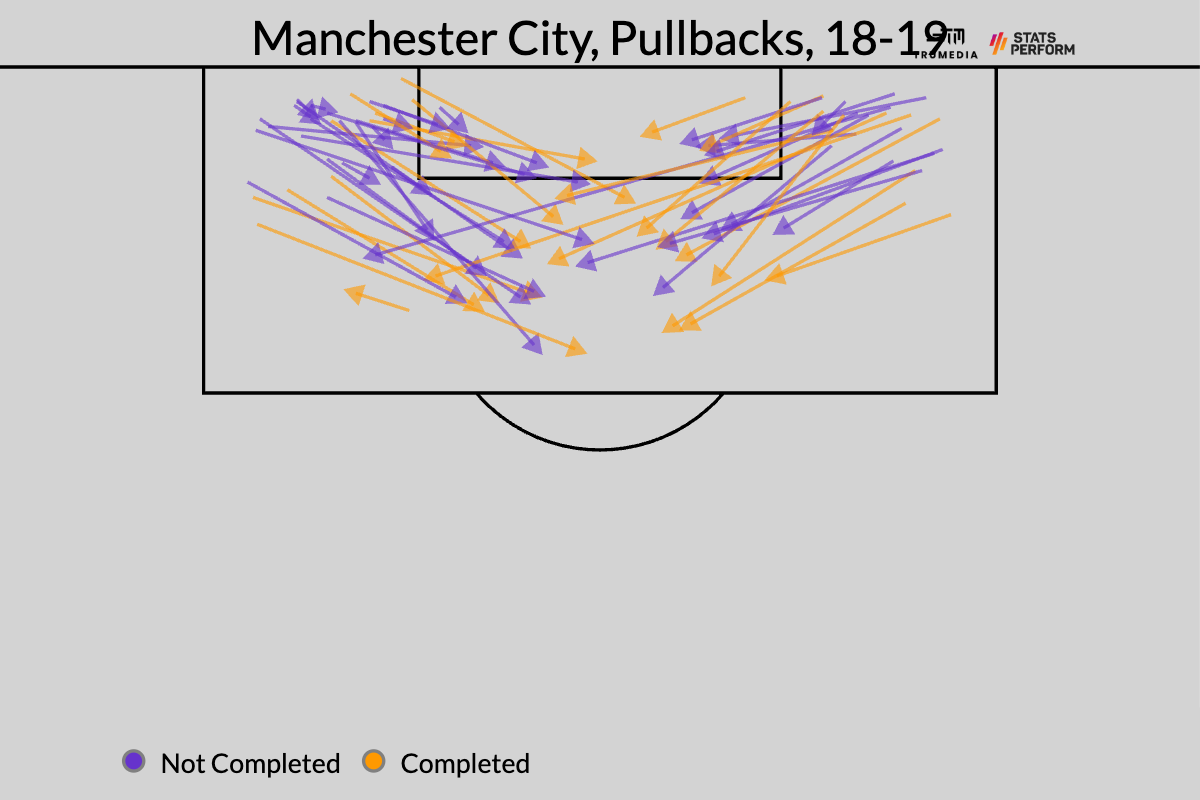
City also led the league in how frequently they attempted to switch play, or quickly play the ball to the opposite side of the field: about six times per 90 minutes. They'd draw the opposition to one side of the field, switch it to the other and then, eventually, the winger would drive to the end line and create a pullback.
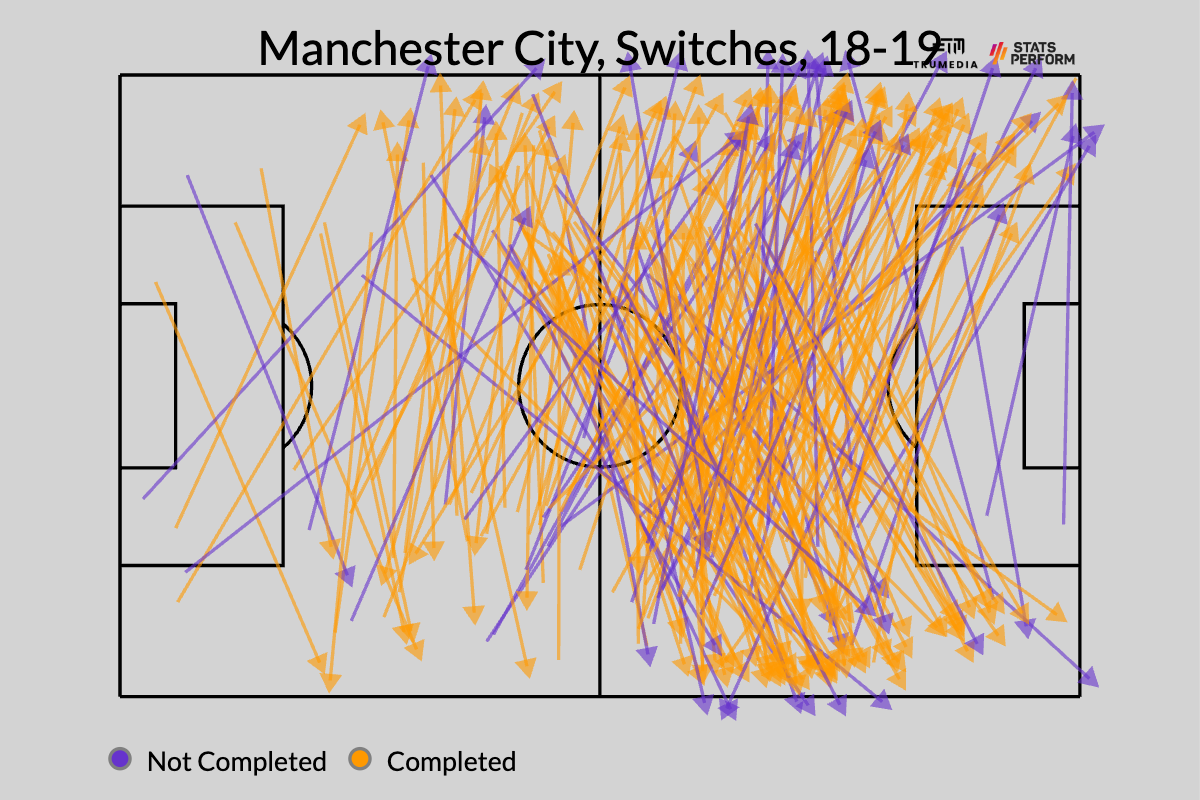
These were the classic patterns of Guardiola play -- as was their desire for total control. Their field tilt (the share of all the final-third passes in their matches) was a league-best 74%. They also led the league in two of the more basic pressing metrics: passes allowed per defensive action (PPDA) and opposition pass-completion percentage allowed.
Five years later, only four City players remain:
Goalkeeper: Éderson
Left-back: Josko Gvardiol
Center-backs: Rúben Dias and John Stones
Right-back: Kyle Walker
Defensive midfield: Rodri
Central midfield: Bernardo Silva and Julián Álvarez
Left wing: Jérémy Doku
Right wing: Phil Foden
Center-forward: Erling Haaland
And with those changes in personnel, pretty much all of those stylistic markers have disappeared. City are creating only 0.9 pullbacks per 90 minutes this season -- just the 10th most in the 20-team Premier League. They're playing 2.7 switches per 90, which is the 12th most in the league. Their pressing rates have plummeted, too: down to 11th in PPDA and 11th in opponent pass-completion percentage.
Despite all of that, they still lead the league in field tilt -- how might you do that if you're not preventing your opponent from getting into your defensive third? You move very slowly once you get the ball into their defensive third.
In the past, City's best defense was, well, not having to defend. But now, with Gvardiol and a five-years-older Walker essentially functioning as third and fourth center-backs -- these are not traditional full-backs -- City are happy to let opponents attack them. And once they get the ball, City are not switching play and attacking weak spots to create pullbacks. They're methodically and deliberately moving the ball until Haaland can find enough space to smash one in.
Typically, teams that press don't move the ball upfield quickly because it's already up the field. And teams that don't press do move the ball quickly because one of the advantages of not pressing is that it encourages your opponent to push bodies forward and then creates all kinds of space behind their defensive line for you to attack into. City have broken that relational chain -- and so have Liverpool, just in the opposite direction:
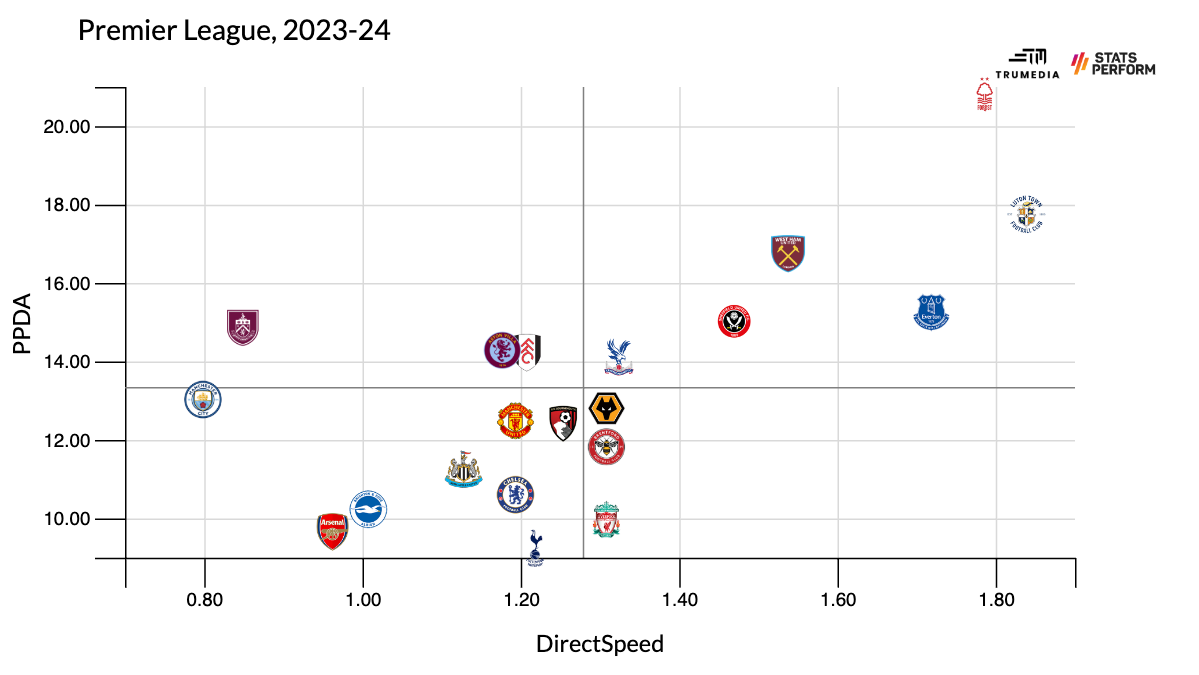 (Direct speed measures how quickly a team moves the ball upfield in meters per second.)
(Direct speed measures how quickly a team moves the ball upfield in meters per second.)
Back in 2018-19, Liverpool didn't stand out in too many statistical ways when compared to City. They were second or third best in just about every attacking and defensive metric. They pressed high, kept the ball in the attacking third, lived in the opposition penalty area -- all that good stuff that produces great teams. They just weren't as great as perhaps the greatest English team of all time. And for as excellent as Liverpool were, they weren't weird: two attacking full-backs, three great attackers, and a conservative midfield that covered everything up.
However, the one area where Liverpool really differed from their peers was in the number of possessions they had per game. Klopp's team averaged 99 possessions per game -- more than everyone other than Everton and two of that season's relegated sides, Huddersfield Town and Fulham. City, meanwhile, were last with 86 possessions per game. While both clubs played most of their matches in the opposition half, City accomplished it without the ball turning over as much, while Liverpool did it with possession constantly changing hands.
This year, possession is still changing hands quite often for the Reds -- down to 91 possessions per game, though still fourth in the league amidst a Premier League-wide slowdown in play. But let's take a quick look and their new most-used collection of players:
Goalkeeper: Alisson
Left-back: Andy Robertson
Center-backs: Virgil van Dijk and Joël Matip
Right-back: Trent Alexander-Arnold
Defensive midfield: Alexis Mac Allister
Central midfield: Dominik Szoboszlai and Curtis Jones
Left wing: Luis Díaz
Right wing: Mohamed Salah
Center-forward: Darwin Núñez
The back five? Exactly the same. Higher up the field, Salah is still there, and Diaz's style of play isn't too different from Mane.
The big changes? Nunez, a physical, traditional center-forward who can't really contribute to buildup play, has replaced his polar opposite in Firmino, and then all three midfielders are creative midfielders. The result: despite four red cards through 12 matches, Liverpool are creating more pullbacks per game (1.7) than City did five years ago, and more than double what Klopp's side did in 2019-19 (0.6).
And even though the names have remained the same, the roles of at least one of the full-backs has changed. Compared to 2018-19, Alexander-Arnold is playing two fewer crosses and three fewer passes in the attacking third, but he's playing five more total passes and five more passes into the attacking third. Five years ago, TAA stayed wide and created chance after chance, while this season, he's drifting infield and moonlighting as a midfielder:
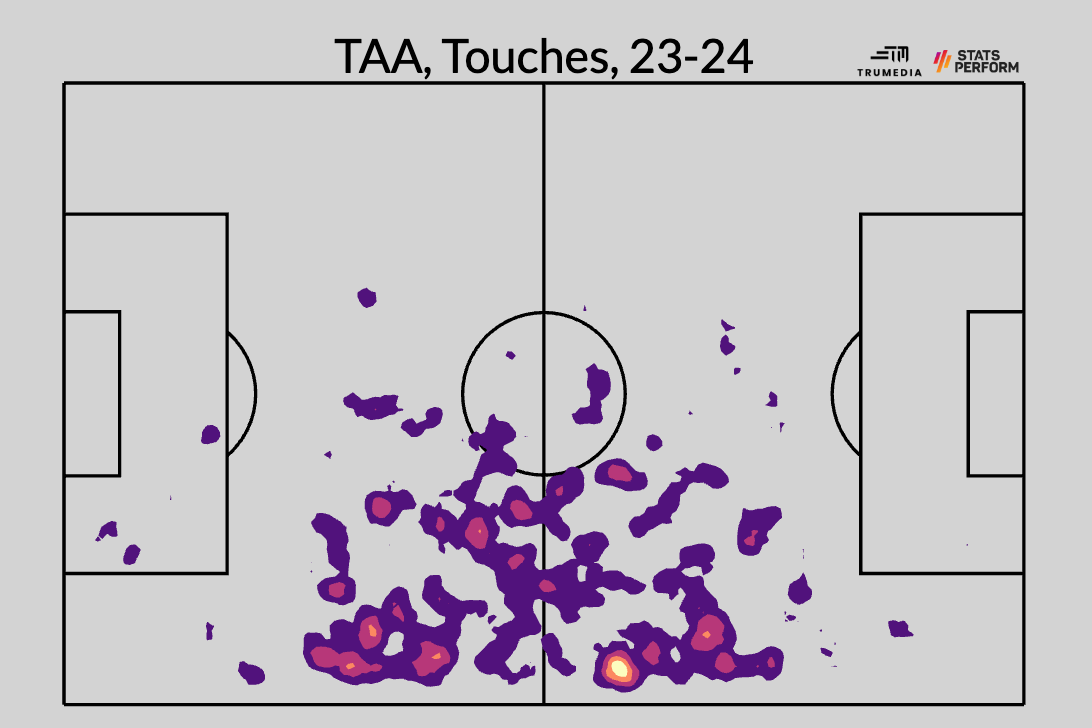
While the two sides currently look nothing alike, Liverpool -- with their pullbacks, aggressive midfielders and reserved full-backs -- are reminding us how their rivals used to play. -- O'Hanlon
How Liverpool perfected their unorthodox rebuild
Liverpool have defied football logic and the accepted rules of team rebuilding to put themselves back in contention this season. How? By rebuilding an entire midfield in the space of one window. MacAllister, Szoboszlai, Wataru Endo and Ryan Gravenberch have come in, with Fabinho, Henderson, Alex Oxlade-Chamberlain and James Milner all leaving.
But it wasn't supposed to be like that.
Let's rewind the clock to the summer of 2022, when Klopp's big squad addition was the £85m club-record signing of Nunez from Benfica. Mane had left for Bayern Munich, but with Diaz arriving from Porto in January 2022 and Nunez being added six months later, Liverpool's attacking plans looked secure for the long term.
It was a phased evolution -- Mane had gone, Firmino would leave at the end of his contract in 2023 and Cody Gakpo would also be signed to join Diaz and Nunez alongside Salah. But while the forward line changed over a period of four windows, the midfield continued to be neglected.
It's no secret that Klopp had wanted a new midfielder throughout the 2022 summer window. Borussia Dortmund's Jude Bellingham was the top target, and Liverpool believed they had laid the groundwork to sign the teenager. But having lost Haaland to City that summer, Dortmund made it clear that Bellingham would not leave until 12 months later.
A late loan deal for Juventus midfielder Arthur Melo bolstered Klopp's midfield numbers, but the Brazilian ended up registering just 13 minutes of first-team football due to injury problems, his addition doing nothing to ease Klopp's concerns over his midfield.
So, the 2023 summer window centered on two top targets -- Bellingham and Chelsea's Mason Mount -- yet Liverpool missed out on both. Bellingham chose Real Madrid. Mount, perhaps surprisingly, opted instead for Manchester United. Liverpool also had to plan for the summer without sporting director Julian Ward, who quit his role after less than a year in the job, leaving Klopp to take a more hands-on role in identifying targets.
With Bellingham and Mount off the table, Liverpool moved quickly to sign Mac Allister from Brighton, but the unexpected departures of Fabinho and Henderson to Saudi Arabia forced Klopp to accelerate the midfield overhaul.
Jorg Schmadtke's arrival as sporting director in the summer proved key. Schmadtke's knowledge of German football, having left a similar role at Wolfsburg earlier this year, enabled him to pinpoint Szoboszlai (RB Leipzig), Endo (VfB Stuttgart) and Gravenberch (Bayern Munich) as the players to fill the void left by Fabinho and Henderson.
Four senior midfielders out and four new ones coming in was an incredible overhaul in one window -- yet Klopp has made it work spectacularly.
Mac Allister and Szoboszlai, in particular, have settled into their roles seamlessly and have given the team experience and top quality in the centre of the pitch. They have also brought energy -- Szoboszlai has added goals and attacking adventure too -- and Klopp goes into the City game with a midfield that can match Guardiola's team in all midfield areas. -- Ogden
How Man City changed the way they played for Haaland
Aguero, a striker, scored just six goals during City's 2020-21 Premier League title-winning season. Midfielder Ilkay Gündogan topped the team's scoring charts in the league with 13 goals, meaning that their move for Tottenham striker Harry Kane in the summer of 2021 was no surprise. Yet City failed to persuade Spurs to offload their talisman and although they would go on to win the 2021-22 title, the lack of a proven goal scorer was again evident, with midfielder Kevin De Bruyne emerging as top league scorer with 15 goals.
Had Kane been signed from Spurs, who knows where Haaland would now be playing? With Kane leading their forward line, City might even have enjoyed last season's treble success a year earlier, but the reality of Haaland's arrival from Dortmund is that it took Guardiola's team to a whole new level.
After a series of failed attempts to win the Champions League, Guardiola knew that his team lacked a clinical goal scorer to become the complete team. Aguero had become City's all-time leading scorer during his time at the Etihad, but the Argentina international had started to fade under Guardiola and the search for a replacement began with Kane but ended with Haaland.
The Norway striker has enabled City to become more direct, and his return of 52 goals in all competitions last season absolutely justified Guardiola's decision to alter the focus of his team. Haaland set a new Premier League record with 36 league goals in a season, and he looked virtually unstoppable in front of goal.
But it hasn't all just been about Haaland. His goals have been decisive, of course, but the signing of Julian Alvarez from River Plate in the same summer also proved key, with the forward scoring 17 goals and registering 5 assists in 49 games in all competitions.
Alvarez proved to be the perfect foil for Haaland, whose smart movement across the forward line gave De Bruyne an outlet for his peerless range of passing. And Guardiola has also given attacking midfielder Bernardo Silva greater freedom to roam around the pitch as a creative force in midfield, largely because the City manager can rely on Rodri to provide a defensive shield in a deep-lying midfield role.
The focal point to all of City's buildup work remains Haaland, however. The 23-year-old stretches teams with his pace and movement and his presence forces opponents to create space for the likes of Alvarez in and around him.
City have become such a well-oiled machine under Guardiola that the summer departures of Gundogan and winger Riyad Mahrez have made little difference. Likewise, the exits 12 months earlier of two other forwards, Raheem Sterling and Gabriel Jesus, also failed to hurt the team's fluidity.
Haaland has missed the injured De Bruyne's creativity this season, but Alvarez, Bernardo, Rodri and summer signing Doku have all combined to make up the shortfall.
The only question that this City side has yet to answer is whether it can prosper without Haaland, as it has been able to without so many other key players. We might find out this weekend, if an ankle injury sustained on international duty keeps Haaland out, but one thing for certain is that Haaland has made all the difference to Guardiola's team since his arrival at the club. -- Ogden
Why Man City and Liverpool are still so closely matched
This chart plots every Premier League club's season since 2018-19 by the team's expected goals, or xG, differential -- adjusted to strip out penalties and minutes played up or down a man at uneven strength -- along with the team's points per game average. The higher they are, the more points they won. The farther to the right they are, the better their underlying performances.
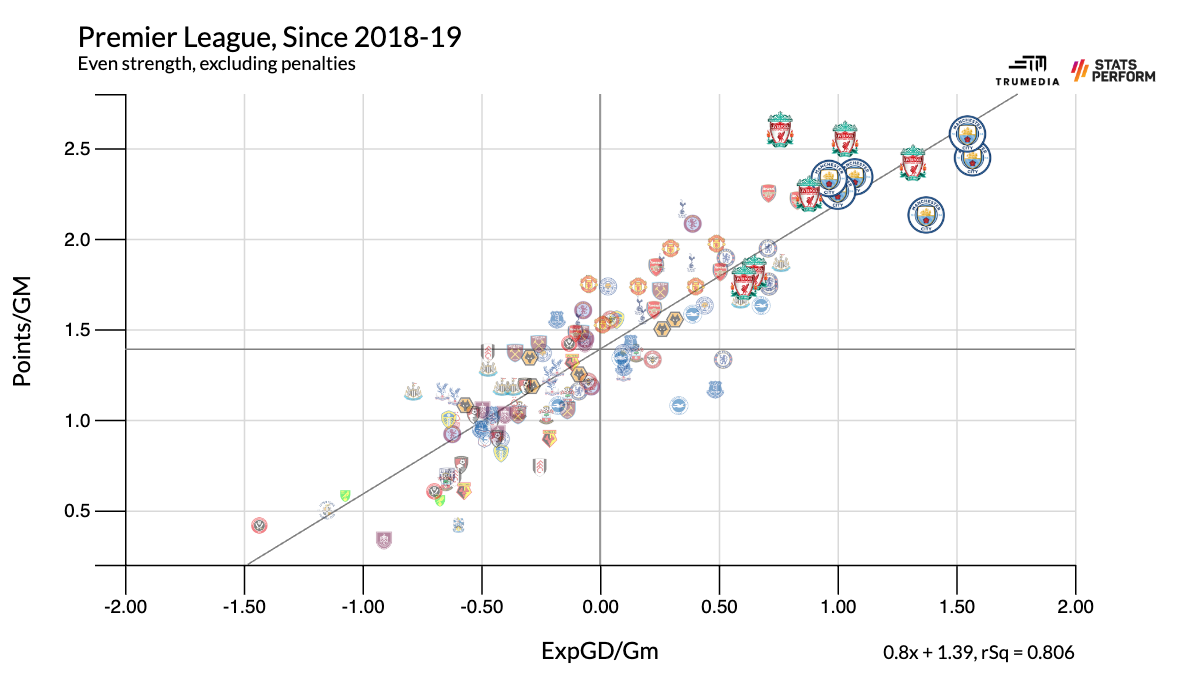
A simple way to look at this is that seven teams have broken the plus-one xG mark since 2018: every Manchester City team before this year, and two Liverpool sides (18-19 and 21-22) that didn't win the title, but did make the Champions League final.
More interesting, I think, are the eighth- and ninth-place teams on the list. That would be this year's City (plus-0.96), and this year's Liverpool (plus-0.88).
Here's everyone from this season, sorted by that same adjusted xG differential:
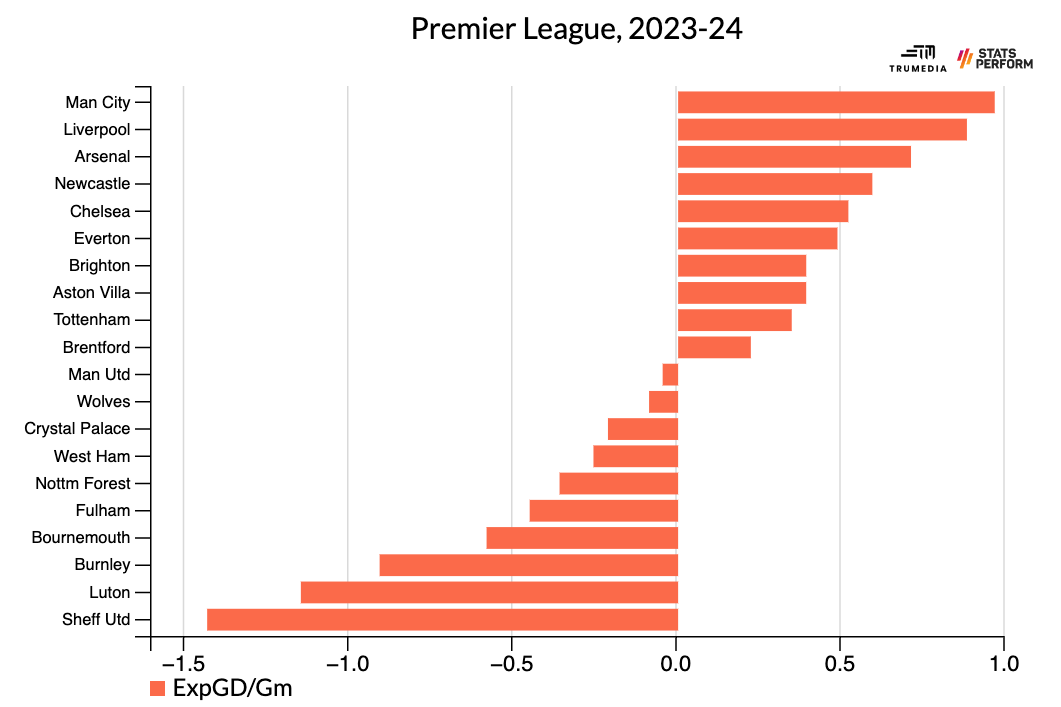
Neither team is perfect -- and Arsenal, both last year and this year, are pushing to be in the same statistical group, too. While City's xG difference is best in the league, it's also lower than it has been in any full season since Guardiola's first year with the club. Their disconnected style of play can get gummed up at times, leading to matches where they barely take any shots -- that's something that never happened in the past.
Liverpool, meanwhile, are registering only the ninth-most touches in the box of any team in the league at even strength, and they're allowing more touches in their box than either City or Arsenal. Can they continue to produce an elite balance of chances while not controlling the most important area on the field at an elite level?
City, of course, have done all of this without arguably their best player: De Bruyne. His return (hopefully in early 2024) presents quite a clear path to internal improvement, as does the reintegration of the likes of Stones and Jack Grealish into consistent roles in league play.
Liverpool's biggest immediate upgrade would be either a world-class defensive midfielder or a world-class center-back -- both of which will be difficult and incredibly expensive to acquire midseason. They need cover for Alexander-Arnold at right-back, too. But most of those moves feel like summer acquisitions -- unless they're in the middle of a title race and a few points added from a new player could legitimately win the team a trophy.
And might they be in that spot? The Sporting Index betting market thinks not, as it projects City to end the year on 88 points, with Liverpool on 78 and Arsenal on 79 -- and then another massive gap down to Tottenham on 66 points in fourth. The most likely outcome, as ever, is another City title. Their depth and their resources are near impossible to overcome over a 38-game season. I say "near impossible" because their opponents on Saturday did already do it once -- and they did it in a season in which they were creating fewer and conceding more xG than they are this year.
Meanwhile, Liverpool are back near where we expect them to be. We'll find out on Saturday if that's enough to bring them back to where they've been: neck and neck with Manchester City, from start to finish. -- O'Hanlon


